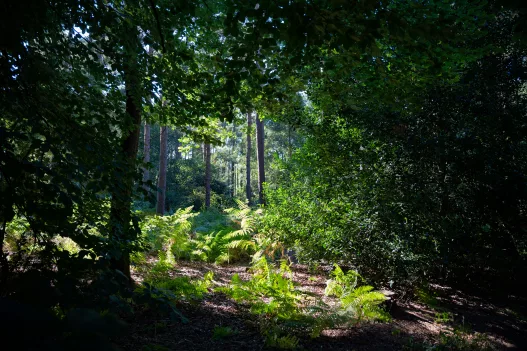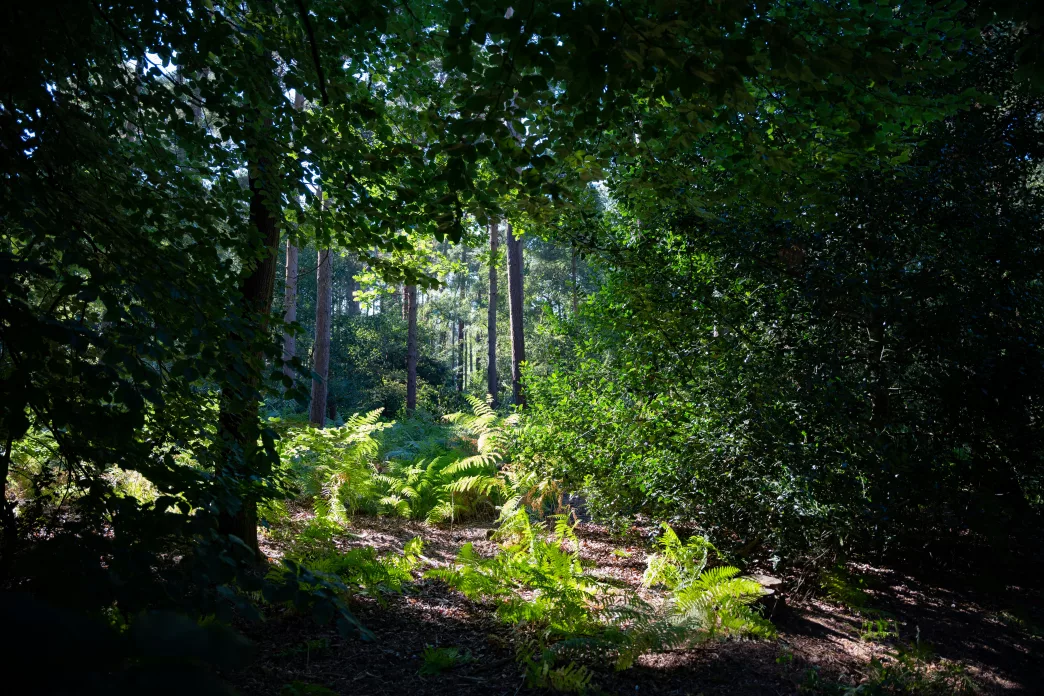Manchester’s surrounding countryside offers numerous forest trails perfect for weekend escapes from urban life. The area features diverse woodland landscapes ranging from ancient oak forests to pine-covered hillsides, all within easy reach of the city centre.
The best forest trails near Manchester include Etherow Country Park, Longshaw Estate, and Rivington Pike, each offering unique experiences for different skill levels and interests. These locations provide well-maintained paths suitable for casual walkers and serious hikers alike.
Whether seeking family-friendly woodland adventures, wildlife watching opportunities, or dog-friendly routes, Manchester’s nearby forests cater to various preferences. The region’s hidden gems and lesser-known escapes offer peaceful alternatives to busier tourist destinations, whilst sustainable exploration practices ensure these natural spaces remain protected for future generations.
Top Forest Trails Near Manchester
These three forests offer distinct experiences within an hour’s drive of Manchester city centre. Each location provides well-maintained paths suitable for various fitness levels and hiking preferences.
Delamere Forest Walks
Delamere Forest covers 972 hectares of Cheshire countryside, positioned 45 minutes southwest of Manchester. The forest features seven colour-coded trails ranging from 1.5 to 6 miles in length.
The Red Trail spans 6 miles and takes hikers through dense woodland areas with occasional clearings. This route includes moderate inclines and provides views across the Cheshire Plain.
Family-friendly options include the Blue Trail (2.5 miles) and Yellow Trail (1.5 miles). Both paths remain relatively flat with firm surfaces suitable for pushchairs.
The forest contains three car parks with facilities including toilets and a visitor centre. Parking costs £3 for four hours on weekdays and £4 on weekends.
Wildlife spotting opportunities include red deer, badgers, and over 80 bird species. The forest’s mixed woodland contains oak, birch, and pine trees alongside heathland areas.
Macclesfield Forest Paths
Macclesfield Forest sits 30 minutes southeast of Manchester in the Peak District foothills. The area encompasses 1,200 hectares of coniferous and deciduous woodland.
Trentabank Reservoir forms the centrepiece of the forest’s main walking circuit. This 3-mile loop follows the water’s edge before climbing through spruce plantations.
The Tegg’s Nose extension adds 2 miles to the reservoir walk. This section includes steeper terrain with stone steps and wooden boardwalks across boggy ground.
Ridgegate Reservoir offers a shorter 1.5-mile circular route. The path remains level throughout and provides benches at regular intervals.
Free parking is available at multiple locations including the main Trentabank car park. Forest Enterprise maintains the paths and provides waymarking signs throughout the area.
The forest’s higher altitude (up to 400 metres) creates cooler temperatures and occasional mist. Visitors should wear appropriate footwear as paths can become muddy after rainfall.
Tegg’s Nose Country Park Routes
Tegg’s Nose Country Park combines historic quarrying heritage with panoramic Cheshire views. The park lies 25 minutes southeast of Manchester near Macclesfield.
The Quarry Trail covers 2 miles and explores former stone extraction sites. Information boards explain the area’s industrial history and geological features.
The Gritstone Trail passes through the park as part of its 35-mile route. This section offers elevated views towards Manchester and the Pennines on clear days.
Shorter walks include the 1-mile Heritage Trail and 0.5-mile Sculpture Trail. Both routes feature interpretation panels and art installations.
The park provides free parking and visitor facilities including toilets and a café. Opening hours are 8am to 6pm daily during summer months.
Stone walls and quarried edges create hazards in some areas. The park authority advises visitors to stay on marked paths and supervise children carefully.
Family-Friendly Woodland Adventures
Manchester’s surrounding forests offer numerous accessible trails and dedicated play areas that cater specifically to families with children of all ages and abilities.
Accessible Trail Options
Delamere Forest provides the most comprehensive family-friendly trail network within 30 minutes of Manchester city centre. The Linmere Trail stretches 2.5 miles on completely flat terrain with a smooth tarmac surface suitable for pushchairs and wheelchairs.
Tatton Park features three designated family routes ranging from 1-3 miles. The Mere Trail offers boardwalks over water sections and has benches positioned every 500 metres for rest stops.
Etherow Country Park in Stockport maintains a 1.8-mile circular path with minimal elevation changes. The trail includes interpretation boards every quarter-mile explaining local wildlife and plant species to engage young visitors.
Chorlton Water Park provides a fully accessible 2-mile loop around the lake with dedicated parking spaces and accessible toilet facilities at the visitor centre.
Nature-Themed Play Areas
Delamere Forest houses the region’s largest natural play area featuring timber climbing frames, rope swings, and sand pits integrated into the woodland setting. The Go Ape Junior course accommodates children aged 6-17 with varying difficulty levels.
Heaton Park contains multiple adventure playgrounds including the Adventure Playground with zip lines and climbing walls surrounded by mature trees. The Pets Corner allows children to interact with farm animals.
Marple Memorial Park offers a woodland-themed play area with carved wooden sculptures and nature trails designed for toddlers and primary school children.
Whitworth Water Park features an outdoor education centre with pond dipping facilities and guided nature walks available at weekends.
Hidden Gems: Lesser-Known Forest Escapes
These secluded woodland areas offer tranquil hiking experiences away from Manchester’s busier trails. Both locations feature diverse ecosystems and well-maintained paths suitable for various skill levels.
Etherow Country Park Discovery
Etherow Country Park spans 240 acres along the River Etherow in Stockport, just 30 minutes from Manchester city centre. The park features four distinct circular trails ranging from 1.2 to 4.5 kilometres in length.
The Riverside Trail follows the Etherow’s meandering course through ancient woodland. Visitors encounter centuries-old oak and ash trees whilst spotting kingfishers and grey herons along the water’s edge.
Compstall Nature Reserve forms the park’s eastern section. This former industrial site now hosts diverse wildlife including roe deer, foxes, and over 60 bird species.
The Woodland Trail climbs gradually through mixed forest canopy. Seasonal highlights include:
- Spring: Bluebells carpet the forest floor
- Autumn: Spectacular leaf colour displays
- Winter: Clear views through bare branches
Practical Information:
- Parking: Free on-site car park
- Facilities: Visitor centre, café, toilets
- Access: Open daily, dawn to dusk
- Difficulty: Easy to moderate
Haigh Woodland Park Exploration
Haigh Woodland Park encompasses 250 acres of mixed woodland near Wigan, approximately 45 minutes from Manchester. The park offers six colour-coded trails through varied terrain including ancient deciduous forest and managed pine plantations.
The Red Trail provides the most challenging route at 3.8 kilometres. This path ascends through mature beech and sycamore stands before reaching elevated viewpoints overlooking the Lancashire countryside.
Haigh Hall sits centrally within the park grounds. The 19th-century mansion now houses a café and information centre, making it an ideal rest stop during longer walks.
The Blue Trail suits families with its gentle 2.1-kilometre route. This path passes through the park’s sculpture trail, featuring contemporary artworks integrated into the natural landscape.
Key Features:
- Adventure playground for children
- Orienteering course with permanent markers
- Wildlife hide overlooking the main pond
- Miniature railway operating weekends
Visitor Information:
- Opening hours: 8:00 AM – 6:00 PM daily
- Parking: £3 all-day fee
- Facilities: Toilets, café, gift shop
Best Trails For Wildlife Watching
Manchester’s surrounding forests offer excellent opportunities to observe red deer in their natural habitat and discover diverse bird species. Early morning visits between April and September provide the most rewarding wildlife encounters.
Red Deer Spotting Routes
Tatton Park features the most reliable red deer sightings within 30 minutes of Manchester city centre. The Deer Park Trail runs 2.5 miles through ancient parkland where herds graze openly.
Visitors should arrive between 6:30-8:00 AM or 5:00-7:00 PM when deer are most active. The Tower Hide offers sheltered viewing approximately 800 metres from the main car park.
Lyme Park provides another excellent location with its Red Deer Sanctuary Walk. This 3-mile circular route passes through mixed woodland and open moorland.
The best viewing spots include:
- Cage Hill viewpoint – panoramic views across the deer park
- Lantern Wood – sheltered observation area
- Bowstones area – frequent deer crossings during dawn hours
Peak rutting season occurs between September and October when stags are most visible. Visitors must maintain 50-metre distances from all deer for safety.
Birdwatching Hotspots
Pennington Flash Country Park attracts over 180 bird species throughout the year. The Nature Reserve Trail covers 2.8 miles around the main lake and reed beds.
Observation hides are positioned at strategic points including the Causeway Hide and Willow Hide. These provide close-up views of waterfowl and wading birds.
Common species include great crested grebes, herons, and kingfishers. Winter months bring visiting wildfowl such as teal, wigeon, and occasional bitterns.
Chorlton Water Park offers urban birdwatching with excellent facilities. The Riverside Walk follows the River Mersey for 2.2 miles through varied habitats.
Notable species spotted regularly:
- Sand martins (April-September)
- Little egrets (year-round)
- Cormorants (winter months)
- Reed warblers (breeding season)
The Wildlife Centre provides identification guides and current sighting information updated weekly by local volunteers.
Dog-Friendly Woodland Walks
Several Manchester-area forests welcome dogs and provide excellent walking opportunities for pet owners. Many trails permit off-lead exercise, whilst essential facilities support comfortable visits for both dogs and their owners.
Off-Lead Trail Recommendations
Delamere Forest offers extensive off-lead walking areas across its 972 hectares of woodland. The main circular trail spans 3.5 miles and features well-maintained paths suitable for dogs of all sizes.
The Sandstone Trail section within Delamere provides excellent off-lead opportunities. Dogs can explore freely whilst owners enjoy views across the Cheshire Plain.
Rivington Pike features designated off-lead zones on upper moorland sections. The terrain includes rocky outcrops and heather-covered slopes that provide natural exercise challenges for active dogs.
Wigan Flashes nature reserve allows off-lead walking on specific woodland paths. The area combines forest trails with wetland edges, offering varied scents and terrain for curious dogs.
Tatton Park permits off-lead exercise in designated woodland areas. The deer park sections require leads, but extensive forest paths allow freedom for well-behaved dogs.
Facilities for Pet Owners
Water stations are available at Delamere Forest visitor centre and along major trail routes. Portable water bowls can be filled at designated taps near car parks.
Dog waste bins are positioned every 500 metres along popular trails at Delamere and Tatton Park. Disposal bags are provided free at visitor centre entrances.
Parking facilities accommodate dog owners with dedicated spaces close to trail entrances. Delamere Forest charges £3 for day parking, whilst Rivington Pike offers free roadside parking.
Visitor centres stock dog treats, leads, and basic first aid supplies. Tatton Park’s facility includes an outdoor dog washing station for muddy paws.
Café facilities at major locations provide outdoor seating areas where dogs are welcome. Water bowls are typically available upon request.
Planning Your Forest Getaway
Most Manchester forest trails are accessible by car within 30-60 minutes, with public transport options available to several locations. A typical day trip allows 4-6 hours of hiking, whilst weekend breaks offer opportunities for multi-trail exploration.
Transport and Accessibility
By Car: The M60 motorway provides direct access to most forest locations. Peak Forest lies 45 minutes via the A6. Rivington Pike takes 30 minutes through the A58. Parking costs range from free to £5 per day.
Public Transport: Northern Rail serves Hebden Bridge for Hardcastle Crags (15-minute walk from station). Bus services connect to Rivington from Bolton interchange. The 339 bus reaches Marple for Etherow Country Park access.
Accessibility Features: Rivington offers wheelchair-accessible paths near the visitor centre. Tandle Hill provides level walking routes suitable for pushchairs. Most car parks include disabled spaces and toilet facilities.
Peak times occur during weekends and bank holidays. Arriving before 9am ensures better parking availability. Winter months require checking daylight hours, with sunset around 4pm in December.
Suggested Itineraries
Half-Day Adventure (4 hours): Begin at Rivington Pike car park at 9am. Complete the 2.5km circular trail to the tower within 90 minutes. Return via the reservoir path for lunch at the visitor centre.
Full Weekend Break: Day one focuses on Etherow Country Park’s 3km trail, followed by overnight accommodation in Marple. Day two explores Peak Forest’s longer routes, including the 5km Kinder Scout approach.
Multi-Trail Saturday: Start with Tandle Hill’s 1.5km summit walk (1 hour). Drive to Rivington for the extended 4km woodland circuit (2.5 hours). Finish at Pennington Flash for evening wildlife spotting.
Family-Friendly Option: Choose shorter loops under 2km. Pack frequent snack breaks. Hardcastle Crags offers stream play areas for children between walking sections.
Sustainable and Responsible Exploration
Forest trails require careful protection to remain accessible for future generations. Visitors can make a significant difference through simple actions and mindful behaviour.
Leave No Trace principles form the foundation of responsible trail use. Hikers should pack out all rubbish, including food waste and cigarette butts.
Staying on designated paths prevents soil erosion and protects delicate plant life. Creating shortcuts damages vegetation and widens trails unnecessarily.
Wildlife observations should occur from a respectful distance. Feeding animals disrupts their natural behaviour and can make them dependent on human interaction.
Essential Guidelines:
- Use established campsites only
- Keep noise levels to a minimum
- Respect private property boundaries
- Follow seasonal trail closures
Dog owners must keep pets on leads in sensitive areas. This protects ground-nesting birds and prevents disturbance to other wildlife.
Visitors should choose sustainable transport options when possible. Public transport connections serve many Manchester-area trails effectively.
Protecting Water Sources requires special attention. Soap and toiletries should never be used directly in streams or lakes.
Trail maintenance relies heavily on volunteer efforts. Many local groups organise regular clean-up events and path repairs.
Photographers should avoid trampling vegetation for better shots. The most striking images often come from staying on established viewpoints.
Fire Safety remains critical, especially during dry periods. Open fires are prohibited in most forest areas near Manchester.
Seasonal considerations help minimise environmental impact. Spring visits should avoid nesting areas, whilst autumn requires extra care with fallen leaves covering trail markers.
Frequently Asked Questions
Visitors to Manchester’s nearby forest trails commonly ask about accessibility, terrain difficulty, and wildlife viewing opportunities. These woodland areas offer varying levels of challenge and distinct features for different hiking preferences.
What are the top-rated forest trails suitable for a weekend hike near Manchester?
Etherow Country Park provides well-maintained trails through mixed woodland with clear signage. The park features multiple route options ranging from 2-5 kilometres suitable for weekend hikers.
Healey Dell Nature Reserve offers dramatic scenery with its riverside woodland path. The main trail spans 3 kilometres through ancient woodland alongside the River Spodden.
Whitworth Water provides challenging terrain with rewarding views across the valley. The circular route covers 4 kilometres through dense forest and open moorland sections.
Can you suggest tranquil forest walks within a short distance from Manchester city centre?
Heaton Park’s woodland areas lie just 6 kilometres from Manchester city centre. The park contains quiet forest sections away from the main recreational areas.
Boggart Hole Clough sits 4 kilometres north of the city centre in Blackley. This urban woodland provides peaceful walking routes through mature trees and alongside streams.
Philips Park in Prestwich offers wooded paths 8 kilometres from central Manchester. The park features several quiet forest trails connecting to the River Irwell.
Which forest walks near Manchester are considered best for birdwatching and wildlife spotting?
RSPB Fairburn Ings, located 45 minutes from Manchester, provides excellent birdwatching opportunities. The reserve hosts over 200 bird species throughout the year including kingfishers and bitterns.
Dovestone Reservoir’s surrounding woodland attracts peregrine falcons and various woodland birds. The forest paths offer multiple viewing points across different habitats.
Wycoller Country Park features diverse wildlife including roe deer and various bird species. The woodland trails provide quiet observation points for wildlife enthusiasts.
Are there any family-friendly trails in forests close to Manchester that can accommodate pushchairs?
Tandle Hill Country Park offers surfaced paths suitable for pushchairs through woodland areas. The main trail remains level with gentle gradients throughout the 2-kilometre route.
Daisy Nook Country Park provides pushchair-accessible paths along the Medlock Valley. The woodland sections feature solid surfaces suitable for families with young children.
Smithills Country Park near Bolton includes pushchair-friendly forest trails. The lower woodland paths avoid steep terrain whilst maintaining access to scenic forest areas.
Could you list some forest trails that offer flat terrain for an easy weekend walk around Manchester?
The Fallowfield Loop follows a former railway line through woodland sections. This 13-kilometre trail maintains level terrain throughout its route from Chorlton to Fairfield.
Pennington Flash Country Park provides flat forest paths around the water’s edge. The woodland sections remain accessible with minimal elevation changes across 3 kilometres.
Clifton Country Park offers level forest trails suitable for leisurely walks. The paths follow the River Irwell through woodland areas without significant inclines.
Where can I find secluded wooded paths for a peaceful walk in the vicinity of Manchester?
Reddish Vale Country Park provides quiet woodland paths away from main visitor areas. The upper forest trails offer solitude particularly during weekday visits.
Bramhall Park contains secluded woodland sections in its eastern areas. These paths see fewer visitors compared to the main park facilities.
Lyme Park’s woodland areas beyond the main house grounds offer peaceful walking routes. The forest trails in the park’s periphery provide quiet woodland experiences.









